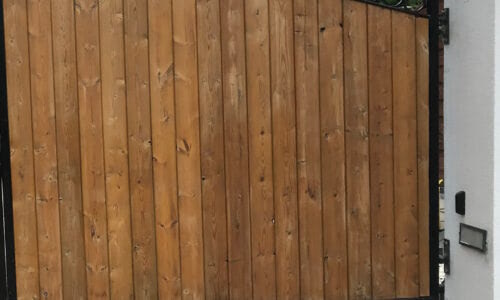As a moving piece of machinery, incorrectly installed or poorly maintained automatic gates pose the risk of serious injury or death to pedestrians. Subsequently, there are several rules and regulations affecting the installation of automatic gates which are in place to ensure electric gates operate safely.
The Supply of Machinery (Safety) Regulations 2008
Automatic gates are considered machinery and as a result fall under the Supply of Machinery (Safety) Regulations 2008. These regulations set out the requirements to be met before machinery can be sold or used in the UK, ensuring that manufacturers show how their machinery meets essential health and safety requirements.
BS EN 12453:2001
Automatic gates are also subject to BS EN 12453:2001, which are the safety standards for powered gates, doors, and barriers. Under these standards;
- The installer must have the necessary equipment to measure the closing and opening forces of the gate, which should be limited to British standards.
- The gates should reverse if they hit an object or pedestrian.
- The gates should feature sensors which detect an object or pedestrian blocking the path of the gate, which can be light beams or rubber safety edges.
- If there are areas where someone could become trapped or crushed by the gate, these parts should be protected. E.g. where a sliding gate passes the gate post.
- All automatic gates must have an emergency release mechanism in case someone becomes trapped.
CE Marking for Automatic Gates
A CE mark demonstrates that the product bearing the mark complies with relevant European standards. Automatic gates are covered by the Machinery Directive and should have a CE mark applied once installed in line with standards. CE marking is still in use in the UK until January 2023, at which time it will be replaced by the UKCA marking.
Automatic Gate Installation Tests
When installing automatic gates, two separate tests should be completed by the installer to check that the gates can be operated safely.
- Risk assessment. A risk assessment will identify any risks associated with the use of the automatic gates in the specific site of installation.
- Force testing. Force testing checks that the gate has been installed according to the manufacturer’s specifications. The gate should be pushed with increasing force until it triggers the safety mechanism to stop and reverse.
The results of both of these tests should be provided to the customer by the gate installer. Any risks that cannot be removed must be highlighted and the installer should advise how to use the gate safely in light of these risks. The risks should also be recorded in an installation and maintenance log.
Declaration of Conformity
After installation, you should be provided with a Declaration of Conformity which confirms that the gates adhere to the Machinery Directive.
Automatic Gate Maintenance
Regular maintenance is the best way to ensure that automatic gates continue to work safely after installation. Most installers will also provide a maintenance service to check for any potential faults or new risks and ensure the gates continue to adhere to all relevant safety standards.
All maintenance should be recorded in the installation and maintenance log.
User Instructions for Automatic Gates
Make sure your gate installer provides you with instructions for how to use your gates safely to prevent any avoidable accidents when operating the gates.
Planning Permission for Automatic Gates
Generally, planning permission is not required for new automatic gates or automatic gates which are replacing an existing gate, as long as;
- The gate does not exceed one metre in height if it is next to a highway.
- The gate does not exceed two metres in height if it is elsewhere.
- No part of the site is listed.
- The gate does not form a boundary with a neighbouring listed building.
- The right to put up gates has not been removed by a planning condition.
In a conservation area, you may need planning permission to replace an existing gate, wall, or fence.
Find Out More About Automatic Gates
To enquire about upgrading your own property with automatic gates, speak to Access Control Solutions. Working with a reputable installer will ensure that your new gates are installed in accordance with all relevant rules and regulations, so you can enjoy the peace of mind that your property is secure and your family and visitors are safe.
Complete our contact form to get in touch, or call 0116 236 6044 to arrange a site visit.
Posted in Gates
